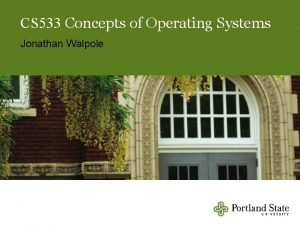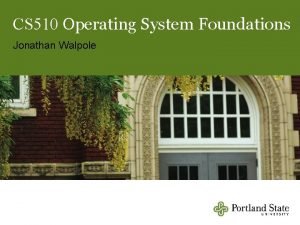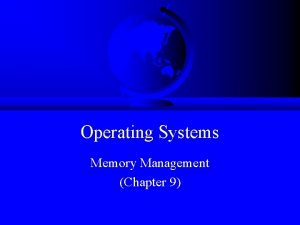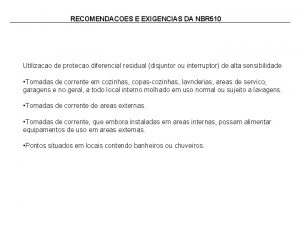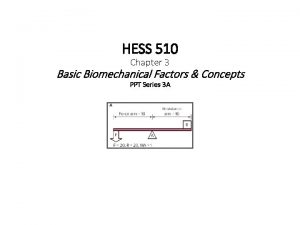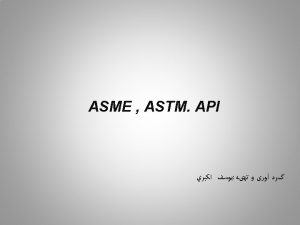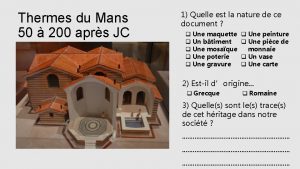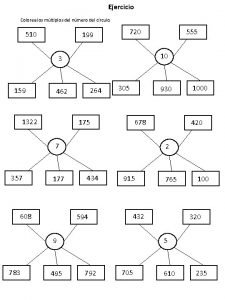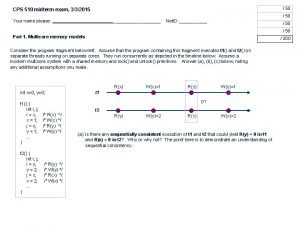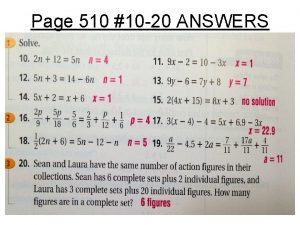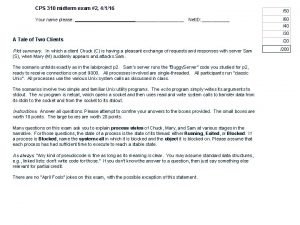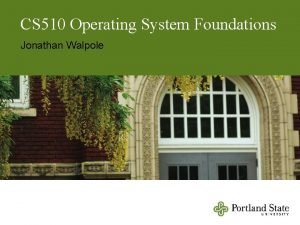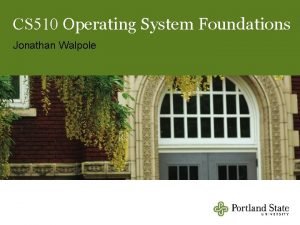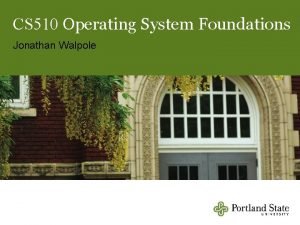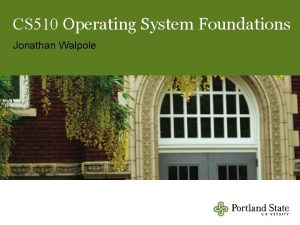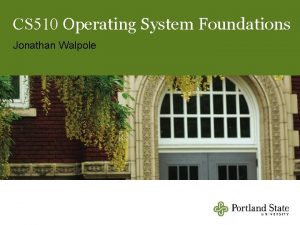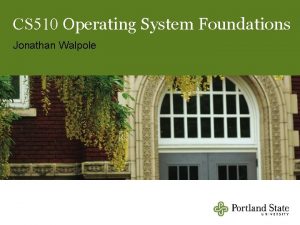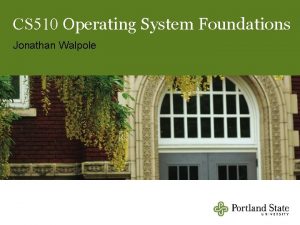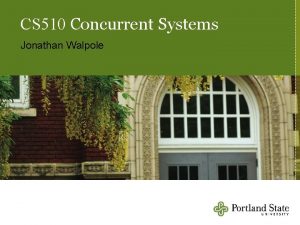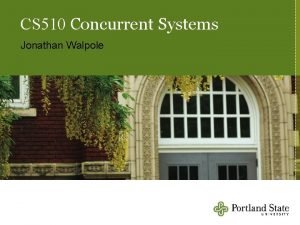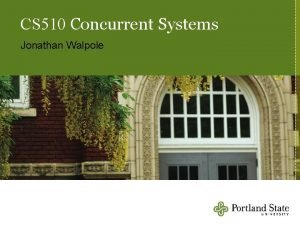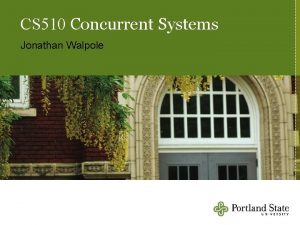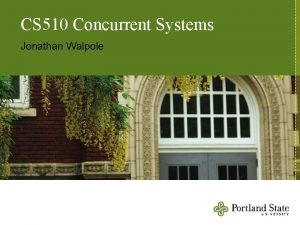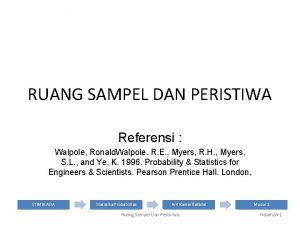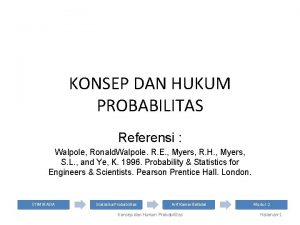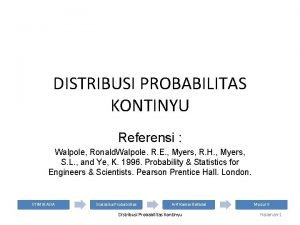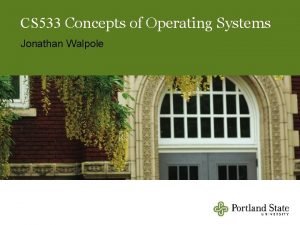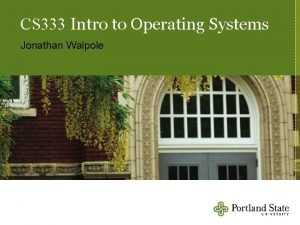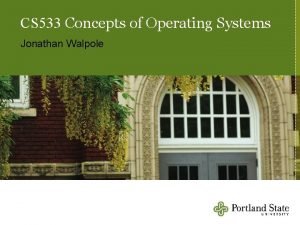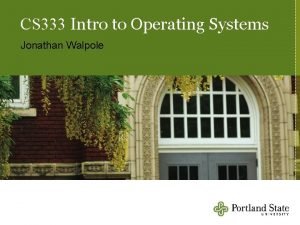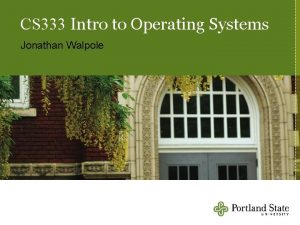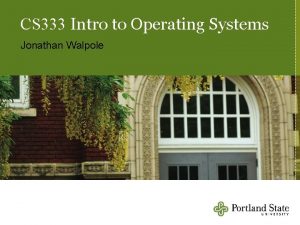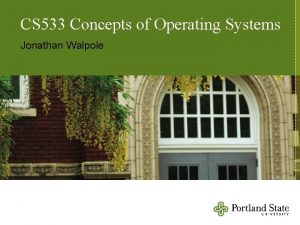CS 510 Operating System Foundations Jonathan Walpole Memory
























































- Slides: 56

CS 510 Operating System Foundations Jonathan Walpole

Memory Management

Memory Management Memory – a linear array of bits, bytes, words, pages. . . - Each byte is named by a unique memory address - Holds instructions and data for OS and user processes Each process has an address space containing its instructions, data, heap and stack regions When processes execute, they use addresses to refer to things in their memory (instructions, variables etc). . . But how do they know which addresses to use?

Addressing Memory Cannot know ahead of time where in memory instructions and data will be loaded! - so we can’t hard code the addresses in the program code Compiler produces code containing names for things, but these names can’t be physical memory addresses Linker combines pieces of the program from different files, and must resolve names, but still can’t encode addresses We need to bind the compiler/linker generated names to the actual memory locations before, or during execution

Binding Example 0 Prog P : : foo() : : End P P: : push. . . jmp _foo : foo: . . . Compilation Library Routines 100 P: : : push. . . jmp 175 jmp 75 : : 75 foo: . . . Assembly 175 foo: . . . Linking 1000 Library Routines 1100 P: : push. . . jmp 1175 : 1175 foo: . . . Loading

Relocatable Addresses How can we execute the same processes in different locations in memory without changing memory addresses? How can we move processes around in memory during execution without breaking their addresses?

Simple Idea: Base/Limit Registers Simple runtime relocation scheme - Use 2 registers to describe a processes memory partition - Do memory addressing indirectly via these registers For every address, before going to memory. . . - Add to the base register to give physical memory address - Compare result to the limit register (& abort if larger)

Dynamic Relocation via Base Register Memory Management Unit (MMU) - Dynamically converts re-locatable logical addresses to physical addresses Relocation register for process i Max Mem 1000 Max addr process i Program generated address 0 + MMU Physical memory address 0 Operating system

Multiprogramming: a separate partition per process What happens on a context switch? Store process base and limit register values Load new values into base and limit registers Partition E limit base Partition D Partition C Partition B Partition A OS

Swapping When a program is running. . . The entire program must be in memory Each program is put into a single partition When the program is not running why keep it in memory? Could swap it out to disk to make room for other processes Over time. . . Programs come into memory when they get swapped in Programs leave memory when they get swapped out

Swapping Benefits of swapping: Allows multiple programs to be run concurrently … more than will fit in memory at once Max mem Swap in Process m Process k Process i Process j Swap out Operating system 0

Fragmentation

64 576 896 O. S. 128 288 128 P 1 320 O. S. 128 288 P 2 224 P 3 288 224 320 P 1 320 O. S. 128 64 P 3 96 P 4 P 3 P 1 64 P 3 352 64 288 64 P 3 96 P 4 128 320 O. S. 128 288 64 P 3 96 288 96 P 4 128 96 P 5 224 O. S. 128 ? ? ? P 6 128

Dealing With Fragmentation Compaction – from time to time shift processes around to collect all free space into one contiguous block - Memory to memory copying overhead - Memory to disk to memory for compaction via swapping! 64 P 3 256 288 96 P 4 128 96 P 3 ? ? ? P 6 288 128 P 4 128 P 5 224 O. S. 128 P 6

How Big Should Partitions Be? Programs may want to grow during execution - How much stack memory do we need? - How much heap memory do we need? Problem: - If the partition is too small, programs must be moved - Requires copying overhead - Why not make the partitions a little larger than necessary to accommodate “some” cheap growth? -. . . but that is just a different kind of fragmentation

Allocating Extra Space Within

Fragmentation Revisited Memory is divided into partitions Each partition has a different size Processes are allocated space and later freed After a while memory will be full of small holes! - No free space large enough for a new process even though there is enough free memory in total If we allow free space within a partition we have fragmentation External fragmentation = unused space between partitions Internal fragmentation = unused space within partitions

What Causes These Problems? Contiguous allocation per process leads to fragmentation, or high compaction costs Contiguous allocation is necessary if we use a single base register -. . . because it applies the same offset to all memory addresses

Non-Contiguous Allocation Why not allocate memory in non-contiguous fixed size pages? - Benefit: no external fragmentation! Internal fragmentation < 1 page per process region How big should the pages be? - The smaller the better for internal fragmentation The larger the better for management overhead (i. e. bitmap size required to keep track of free pages The key challenge for this approach How can we do secure dynamic address translation? I. e. , how do we keep track of where things are?

Paged Virtual Memory divided into fixed size page frames - Page frame size = 2 n bytes - n low-order bits of address specify byte offset in a page - remaining bits specify the page number But how do we associate page frames with processes? - And how do we map memory addresses within a process to the correct memory byte in a physical page frame? Solution – per-process page table for address translation - Processes use virtual addresses - CPU uses physical addresses - Hardware support for virtual to physical address translation

Virtual Addresses Virtual memory addresses (what the process uses) Page number plus byte offset in page Low order n bits are the byte offset Remaining high order bits are the page number bit 31 bit n-1 20 bits page number bit 0 12 bits offset Example: 32 bit virtual address Page size = 212 = 4 KB Address space size = 232 bytes = 4 GB

Physical Addresses Physical memory addresses (what the CPU uses) Page frame number plus byte offset in page Low order n bits are the byte offset Remaining high order bits are the frame number bit 24 bit n-1 12 bits Frame number bit 0 12 bits offset Example: 24 bit physical address Frame size = 212 = 4 KB Max physical memory size = 224 bytes = 16 MB

Address Translation Hardware maps page numbers to frame numbers Memory management unit (MMU) has multiple offsets for multiple pages, i. e. , a page table - Like a base register except each entries value is substituted for the page number rather than added to it - Why don’t we need a limit register for each page? - Typically called a translation look-aside buffer (TLB)

MMU / TLB

Virtual Address Spaces Here is the virtual address space (as seen by the process) Lowest address Highest address Virtual Addr Space

Virtual Address Spaces The address space is divided into “pages” In BLITZ, the page size is 8 K Page 0 0 1 2 3 4 5 6 7 Page 1 A Page N N Virtual Addr Space

Virtual Address Spaces In reality, only some of the pages are used Unused 0 1 2 3 4 5 6 7 N Virtual Addr Space

Physical Memory Physical memory is divided into “page frames” (Page size = frame size) 0 1 2 3 4 5 6 7 N Virtual Addr Space Physical memory

Virtual & Physical Address Spaces Some frames are used to hold the pages of this process 0 1 2 3 4 5 6 7 These frames are used for this process N Virtual Addr Space Physical memory

Virtual & Physical Address Spaces Some frames are used for other processes 0 1 2 3 4 5 6 7 Used by other processes N Virtual Addr Space Physical memory

Virtual & Physical Address Spaces Address mappings say which frame has which page 0 1 2 3 4 5 6 7 N Virtual Addr Space Physical memory

Page Tables Address mappings are stored in a page table in memory 1 entry/page: is page in memory? If so, which frame is it in? 0 1 2 3 4 5 6 7 N Virtual Addr Space Physical memory

Address Mappings Address mappings are stored in a page table in memory - one page table for each process because each process has its own independent address space Address translation is done by hardware (ie the TLB. . . translation-look-aside buffer) How does the TLB get the address mappings? - Either the TLB holds the entire page table (too expensive) or it knows where it is in physical memory and goes there for every translation (too slow) - Or the TLB holds a portion of the page table and knows how to deal with TLB misses - the TLB caches page table entries

Two Types of TLB What if the TLB needs a mapping it doesn’t have? Software managed TLB - It generates a TLB-miss fault which is handled by the operating system (like interrupt or trap handling) The operating system looks in the page tables, gets the mapping from the right entry, and puts it in the TLB, perhaps replacing an existing entry Hardware managed TLB - It looks in a pre-specified physical memory location for the appropriate entry in the page table The hardware architecture defines where page tables must be stored in physical memory OS loads current process page table there on context switch!

The BLITZ Memory Architecture Page size 8 Kbytes Virtual addresses (“logical addresses”) 24 bits --> 16 Mbyte virtual address space 211 Pages --> 11 bits for page number

The BLITZ Memory Architecture Page size 8 Kbytes Virtual addresses (“logical addresses”) 24 bits --> 16 Mbyte virtual address space 211 Pages --> 11 bits for page number An address: 13 12 23 11 bits page number 0 13 bits offset

The BLITZ Memory Architecture Physical addresses 32 bits --> 4 Gbyte installed memory (max) 219 Frames --> 19 bits for frame number

The BLITZ Memory Architecture Physical addresses 32 bits --> 4 Gbyte installed memory (max) 219 Frames --> 19 bits for frame number 13 12 31 19 bits frame number 0 13 bits offset

The BLITZ Memory Architecture The page table mapping: Page --> Frame Virtual Address: 23 13 12 0 11 bits Physical Address: 31 19 bits

The BLITZ Page Table An array of “page table entries” Kept in memory 211 pages in a virtual address space? ---> 2 K entries in the table Each entry is 4 bytes long 19 bits The Frame Number 1 bit Valid Bit 1 bit Writable Bit 1 bit Dirty Bit 1 bit Referenced Bit 9 bits Unused (and available for OS algorithms)

The BLITZ Page Table Two page table related registers in the CPU - Page Table Base Register - Page Table Length Register These define the “current” page table - This is how the CPU knows which page table to use - Must be saved and restored on context switch - They are essentially the Blitz MMU Bits in the CPU status register - System Mode - Interrupts Enabled - Paging Enabled 1 = Perform page table translation for every memory access 0 = Do not do translation

The BLITZ Page Table 31 frame number 19 bits 13 12 unused dirty bit referenced bit writable bit valid bit 0 D R W V

The BLITZ Page Table page table base register 31 0 1 2 2 K frame frame Indexed by the page number number 13 12 unused unused D D D R R R W W W 0 V V V

The BLITZ Page Table 13 12 23 page number 31 2 K offset virtual address page table base register 0 1 2 0 frame frame number number 13 12 unused unused D D D R R R W W W 0 V V V

The BLITZ Page Table 13 12 23 page number 31 frame frame 2 K offset virtual address page table base register 0 1 2 0 number number 13 12 unused unused D D D R R R W W W 0 V V V 0 31 physical address

The BLITZ Page Table 13 12 23 page number 31 frame frame 2 K offset virtual address page table base register 0 1 2 0 number number 13 12 unused unused D D D 13 12 31 W W W 0 offset physical address R R R 0 V V V

The BLITZ Page Table 13 12 23 page number 31 frame frame 2 K offset virtual address page table base register 0 1 2 0 number number 13 12 unused unused D D D 13 12 31 W W W 0 offset physical address R R R 0 V V V

The BLITZ Page Table 13 12 23 page number 31 frame frame 2 K 31 offset virtual address page table base register 0 1 2 0 number number 13 12 unused unused D D D 13 12 frame number physical address R R R W W W 0 V V V 0 offset

Quiz What is the difference between a virtual and a physical address? What is address binding? Why are programs not usually written using physical addresses? Why is hardware support required for dynamic address translation? What is a page table used for? What is a TLB used for? How many address bits are used for the page offset in a system with 2 KB page size?

Spare Slides

Management Data Structures Each chunk of memory is either - Used by some process or unused (free) Operations - Allocate a chunk of unused memory big enough to hold a new process - Free a chunk of memory by returning it to the free pool after a process terminates or is swapped out

Management With Bit Maps Problem - how to keep track of used and unused memory? Technique 1 - Bit Maps A long bit string One bit for every chunk of memory 1 = in use 0 = free Size of allocation unit influences space required Example: unit size = 32 bits overhead for bit map: 1/33 = 3% Example: unit size = 4 Kbytes overhead for bit map: 1/32, 769

Management With Bit Maps

Management With Linked Lists Technique 2 - Linked List Keep a list of elements Each element describes one unit of memory - Free / in-use Bit (“P=process, H=hole”) Starting address Length Pointer to next element

Management With Linked Lists 0

Management With Linked Lists Searching the list for space for a new process First Fit Next Fit Start from current location in the list Best Find the smallest hole that will work Tends to create lots of really small holes Worst Find the largest hole Remainder will be big Quick Fit Keep separate lists for common sizes
 Jonathan walpole
Jonathan walpole Jonathan walpole
Jonathan walpole Virtual memory in os
Virtual memory in os Memory management in os
Memory management in os Memory management operating system
Memory management operating system Semantics prototype
Semantics prototype Explicit memory
Explicit memory Long term memory vs short term memory
Long term memory vs short term memory Internal memory and external memory
Internal memory and external memory Primary memory and secondary memory
Primary memory and secondary memory Logical address
Logical address Which memory is the actual working memory?
Which memory is the actual working memory? Virtual memory and cache memory
Virtual memory and cache memory Virtual memory in memory hierarchy consists of
Virtual memory in memory hierarchy consists of Eidetic memory vs iconic memory
Eidetic memory vs iconic memory Shared memory vs distributed memory
Shared memory vs distributed memory Buddy system memory
Buddy system memory File system in operating system
File system in operating system File system in operating system
File system in operating system File system in operating system
File system in operating system Nbr510
Nbr510 753-510 a.c
753-510 a.c Toefl itp level
Toefl itp level Cos510
Cos510 510 factors
510 factors Cs 510 uiuc
Cs 510 uiuc Api rp 510
Api rp 510 Chhi 510 book summary of turning points by noll
Chhi 510 book summary of turning points by noll Saae audit
Saae audit Wees mijn verlangen tekst
Wees mijn verlangen tekst Quelle est la nature de ce document
Quelle est la nature de ce document Rodzice roberta mają na działce truskawki. zbieranie
Rodzice roberta mają na działce truskawki. zbieranie Colorea los múltiplos de 3
Colorea los múltiplos de 3 Photoelectric effect practice problems
Photoelectric effect practice problems Acs 510
Acs 510 A daring 510 n swimmer dives
A daring 510 n swimmer dives Number 510
Number 510 Cps 510
Cps 510 Upc 2-507
Upc 2-507 510 pred kristom
510 pred kristom Rtn 510
Rtn 510 Page 510 geometry answers
Page 510 geometry answers Rumus luas sisi prisma belah ketupat
Rumus luas sisi prisma belah ketupat Averages from a grouped frequency table
Averages from a grouped frequency table Cps 510
Cps 510 Cps 510
Cps 510 1-800-510-2020
1-800-510-2020 Idempotent law example
Idempotent law example The foundations logic and proofs
The foundations logic and proofs Preschool curriculum framework
Preschool curriculum framework Psychological foundations of curriculum
Psychological foundations of curriculum New foundations home for child anderson sc
New foundations home for child anderson sc Foundations of a healthy relationship
Foundations of a healthy relationship Indiana learning foundations
Indiana learning foundations History and geography the foundations of culture
History and geography the foundations of culture Biographical characteristics of individual behaviour
Biographical characteristics of individual behaviour Foundations of business 5th edition
Foundations of business 5th edition
